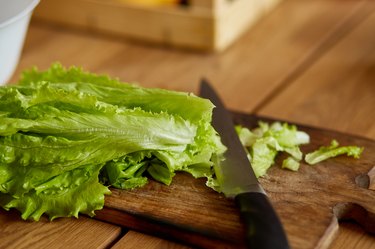
Lettuce, like other foods, can be contaminated with germs that cause food poisoning. Many dishes are cooked before they're eaten, killing off most germs. However, salads are usually eaten raw, increasing the chance you accidentally eat some hidden bacteria. Lettuce food safety tips can help.
With all that happened in 2020, you may not remember everyone avoided romaine in January. That was because 167 people became infected with a bacteria called E. coli — which causes food poisoning — after eating lettuce grown in a particular region in California, according to the Centers for Disease Control and Prevention (CDC). As a result, some romaine lettuce products were pulled off the shelves.
Video of the Day
Video of the Day
Lettuce and other leafy greens are health-promoting veggies that provide an array of nutrients and are essential to any healthy diet. So when a new outbreak of food poisoning is reported, and lettuce is the culprit, it may seem surprising. Why does such a healthy and seemingly innocent vegetable sometimes cause food poisoning (which results in a stomach-flu-like illness)?
There are many opportunities for lettuce to be contaminated with germs that cause food poisoning. "They are grown in soil that can be easily contaminated by organisms in their farm's water supply," says Jenifer R. Lightdale, MD, MPH, a pediatric gastroenterologist at UMass Memorial Children's Medical Center in Worcester, Massachusetts.
"Contamination can also occur during packaging, as well as during transport to stores and restaurants; while sitting in the refrigerator awaiting food preparation; and even at the moment of being prepared for a meal, especially if the cook has not washed their hands."
Washing lettuce does not ensure that no bacteria or germs will be left behind, but it's a good start.
Reduce Your Chance of Getting Sick
Lettuce food safety can help. Next time you go to the store in search of salad materials, look for packaged greens that are labeled "ready to eat," "triple-washed" or "no washing necessary." The CDC says the safety of pre-washed greens is not guaranteed, but they're more likely to be safer than unwashed options and don't need to be rewashed.
If you're planning to eat lettuce that is not "ready to eat," make sure to follow these steps, according to the CDC:
- Wash your hands for 20 seconds with soap and water before and after preparing leafy greens.
- Discard outer leaves and any torn or bruised ones.
- Rinse the leafy greens
under running water and use your hands to gently rub the surface of the leaves.
- Don't soak leafy greens in a sink filled with water. They can get contaminated with germs in the sink.
- Don't soak leafy greens in a bowl filled with water. Contamination from one leaf can spread through the water to other leaves.
- If you do not have access to safe tap water, rinse with other drinkable water (such as filtered, bottled or distilled water).
- Dry leafy greens with a clean cloth or paper towel.
To safely store your lettuce, follow these tips from the CDC:
- Store it separately from raw meats.
- Keep it in the refrigerator.
Illnesses From Eating Bad Lettuce
The CDC estimates that germs on raw produce are responsible for most food poisoning outbreaks in the United States., and many of these outbreaks start with lettuce. Most of the time, lettuce that causes food poisoning is contaminated with:
- Norovirus
- E. coli bacteria
- Salmonella
It takes around 2 to 6 hours for food poisoning symptoms to arise after eating contaminated lettuce or other tainted foods, according to the U.S. National Library of Medicine (NLM). The time it takes to develop symptoms and the types of symptoms you experience can vary depending on the germ, but food poisoning generally comes with symptoms like:
- Abdominal cramps
- Diarrhea (which may be bloody)
- Fever and chills
- Headache
- Nausea and vomiting
- Weakness (which may be serious)
While food poisoning can be undoubtedly miserable, most cases will resolve within 12 to 48 hours, per the NLM.
Tip
Unless there is a recall of your favorite lettuce, don't stop eating it, as the health benefits likely outweigh the risks of food poisoning.
- Centers for Disease Control and Prevention: “Outbreak of E. coli Infections Linked to Romaine Lettuce”
- Jenifer R. Lightdale, MD, MPH, pediatric gastroenterologist, UMass Memorial Children's Medical Center; professor, University of Massachusetts Medical School, Worcester, Massachusetts
- Centers for Disease Control and Prevention: “Lettuce, Other Leafy Greens, and Food Safety”
- U.S. National Library of Medicine: “Food Poisoning”
Is this an emergency? If you are experiencing serious medical symptoms, please see the National Library of Medicine’s list of signs you need emergency medical attention or call 911.